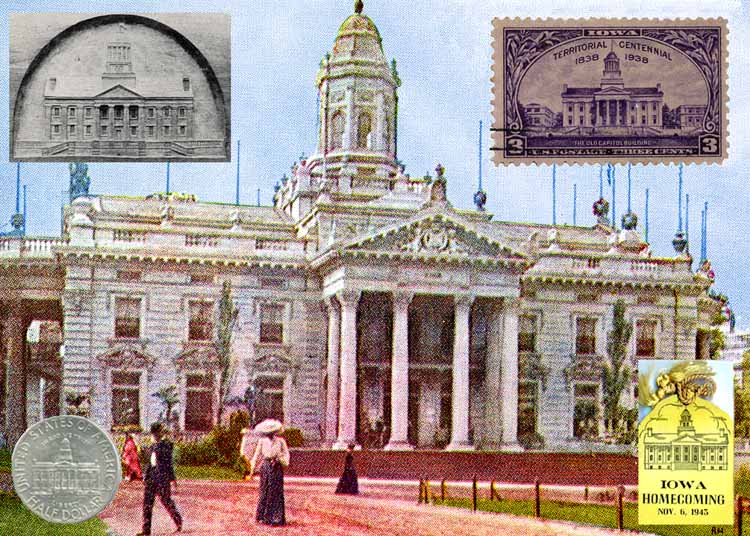Saturday
Postcard 216: Old Cap Image Really Gets Around
On
a background image of a stylized replica of Old Capitol erected at the
1904 World’s Fair in St. Louis
appear an assortment of Old Cap likenesses (clockwise from upper left)
as the Bily sanctuary clock in
Spillville, 1938 U.S. postage stamp, 1943 UI homecoming badge and 1946
U.S. half dollar.
Collage created by Bob Hibbs.
|
By
Bob Hibbs The image of Old Capitol really gets around; and,
in doing so has become arguably the most recognized symbol in Iowa. Without doubt, the University of Iowa tiger Hawk,
the stunning campanile on the Iowa State campus or the splendid
five-domed capitol in Des Moines are more recognized by some, but these
images pale at the ubiquitous appearances of Iowa City’s Old Capitol
through more than 160 years. In 1938 just three cents would mail a first class
letter, and one could purchase the frank with an image of Old Capitol
emblazoned on it. The U.S. stamp commemorated the Territory of Iowa
centennial even though the territory existed only eight years from 1838
until the State of Iowa was established. A serial-numbered corner block of four of the
stamps now will cost about $5, about the same as a first-day cover
postmarked Iowa City. A homecoming badge in 1943 cost perhaps 25¢ and was
printed black on gold cardboard featuring a frontal view of Old
Capitol. Use of metal for such purposes was prohibited at the time to
direct metal into the manufacture of World War II war material. Many of
the badges were destroyed during the rain-soaked game, making them rare. Today an authentic 1943 paper badge in good
condition sells for about $2,000. However, Old Cap’s image on eight
other homecoming badges from years past cost considerably less. The U.S. mint helped mark Iowa’s state centennial
in 1946 by issuing a half dollar coin featuring Old Capitol. It sold then, of course,
for 50¢; but, now it takes about $50 for one in good condition, and
collectors pay several hundred dollars for one in a high-rated
condition. An unusual place to find an Old Capitol image is a
stereographic slide of paired images taken at the 1904 St. Louis
World’s Fair. It isn’t truly Old Cap, but one polluted by designers
with strains of the Des Moines capitol. Commentators at the time tell us the composite
design created an impressive presence on the fair’s Avenue of the
States, designating it the best of the buildings erected by states to
house their self promotions. A hand-carved image of Old Capitol even appears on
the 1930 intricate “sanctuary” clock, a 9½-foot tall creation which the
celebrated Bily brothers took nearly three years to complete. Farmers
and carpenters, the brothers forged their masterpieces in wood as a
hobby with home-make tools. They executed the sanctuary clock in black walnut,
oak and boxwood at the family farm near the small northeast Iowa town
of Spillville where much of their work remains in a public museum. The
pieces were not commercially made, and have never been sold. Several series of plates have included the likeness
of Old Capitol. Among the most popular has been a 12-plate blue on
white Wedgwood ceramic set issued five times between 1933 and 1974.
Each plate carries an issue date. Curiously, the 1938 and 1974 sets
both also carry a “Third Edition” notation. These plates dated in the 1930s frequently sell at
$100 or more per plate. Another popular series is a brown earthenware set
of 11-plates created by Judy Sutcliffe of Green Tree Pottery in Audubon
for the UI Alumni Association. It began with an Old Capitol imaged
plate in 1972 and ended with one featuring Carver-Hawkeye Arena in
1982. They now sell for around $25 each. Scores of decorative ceramic plates and engraved
silver tea spoons that have been marketed through the years are now
considered highly collectable, as are cups and saucers. One of the
fanciest featuring Old Cap is a prize fragile porcelain tea cup and
saucer, gently fluted, issued about 1900. It is valued at several
hundred dollars. Mother would have said, “A fool and his money are
soon parted.”
Next
Saturday:
Looking over a 1900 map of Iowa City and environs. Bob Hibbs collects local postcards and researches history related to them. |
